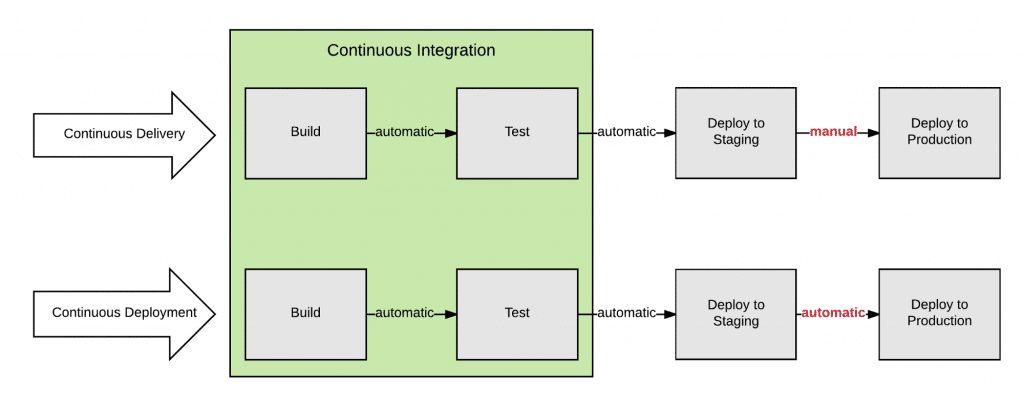Introduction
The persistence of terms like continuous integration, continuous delivery and continuous deployment in conversations among tech-savvy developers in today’s world is undoubted. And to no one’s surprise – the ability of each of the practices to better the software development through making the release process vigorous and efficient makes them appealing. With this being said, the confusion as to how they are related and what their goal consists of is still present. Rather than being mutually exclusive, these operations complement each other while also being able to contribute to the end result individually. To get an idea of what each process is like and how the combination of them all results in the smooth workflow of the system, have a look at the following explanation created for your easier comprehension.
Continuous Integration
The development practice requiring developers to be integrating code into a Trunk, Master or Mainline once or twice per day is known as Continuous Integration (CI). The constant verification is done for the purpose of ensuring the early detection of possible issues. This process involves the automated tests method entailing the framework of a unit test. The construction of the separate server for the continuous execution of these tests is thus mandatory. This way developers are able to integrate codes while other tests on changes are being executed (DigitalVarys, 2019).

CI implementation not only lowers the risk of system bugs being transported to the production, but also enables an almost effortless repair of the issue due to the small amount of coding involved. Also, human connection is stimulated as a result of developers gathering together to figure out in what way one’s code affects the other one’s code. However, precautions have to be taken as well. For instance, automated tests ought to be applied to every newly adopted element or bug fix so that the change is not conflicting with other parts of the system.
Continuous Deployment
The development practice enabling the release of the code to the production stage as soon as possible is known as Continuous Deployment (CI + CD) and is considered to be an upgrade from the mentioned above Continuous Delivery. Notably, User Acceptance Testing (UAT) and large batching are absent, and basic tests are performed before the coding integration act within the framework of production-like mediums. The automation process of this practice is the most advanced out of them all – the deployment can be executed by pressing the specifically assigned button in little to no time. Once the deployment is over, a detailed evaluation of metrics should be executed. This includes response time, user action and traffic, and is often put into graphics for the easy comprehension of the metrics’ positive or negative effects.

Combining Continuous Integration and Continuous Delivery, Continuous Deployment benefits from the frequent check-ins of coding and the absence of errors in the release stage. However, it is crucial to keep in mind that due to every change occurring during the tests being deployed to production, the process is reliant on Feature Toggles when releasing elements to its users. Also called ‘Feature Flags’, this tool authorizes developers to change the behavior of the system without changing the actual coding. This, in turn, causes the system to be quick and efficient.
Automated Workflow
The differences and similarities of the previously described processes allow to deduce the perfect formula for project managers, corporate shareholders and software developers to work in a systematic environment with minimum to no operational errors. The blueprint looks like this: continuous deployment process calls for automated elements to be in place. It is, thus, the automated built-in server, non-stop operating delivery to staging environment and self-operating deploy to production that make up the ideal workflow. The next steps demonstrate the perfectly organized system made automatic from the beginning till the very end (Anastasov, 2017).

Step 1: Software developer is responsible for checking in code to the development sector.
Step 2: Once check in is done, continuous integration server detects the occurring change and integrates it into a Trunk, Master or Mainline development. It also executes unit tests and takes part in the voting procedure on the matter of merging to staging environment as a result of the test outcome.
Step 3: If Step 2 is successful software developer deploys it and executes Quality Assurance for testing the staging environment.
Step 4: If Step 3 is successful, the user votes in favor of moving to production stage. The continuous integration server detects it one more time and rules out whether it is ready to be merged into production.
Step 5: If Step 4 is successful, the system is deployed to the final destination – production environment.
*As per the user’s specific needs and conditions, the process might somewhat vary from time to time (Pittet, n.d.).
These simple 5 steps show that continuous deployment indeed relies on minuscule changes. To be relevant and free of bugs, these changes are continuously tested, fixed and released to the final stage of production straight after they are verified. Developers are the ones who ensure the code’s correct ownership along with the smooth flow of the automated process, which is possible thanks to the above mentioned steps.
Step 2: Once check in is done, continuous integration server detects the occurring change and integrates it into a Trunk, Master or Mainline development. It also executes unit tests and takes part in the voting procedure on the matter of merging to staging environment as a result of the test outcome.
Step 3: If Step 2 is successful software developer deploys it and executes Quality Assurance for testing the staging environment.
Step 4: If Step 3 is successful, the user votes in favor of moving to production stage. The continuous integration server detects it one more time and rules out whether it is ready to be merged into production.
Step 5: If Step 4 is successful, the system is deployed to the final destination – production environment.
*As per the user’s specific needs and conditions, the process might somewhat vary from time to time (Pittet, n.d.).
These simple 5 steps show that continuous deployment indeed relies on minuscule changes. To be relevant and free of bugs, these changes are continuously tested, fixed and released to the final stage of production straight after they are verified. Developers are the ones who ensure the code’s correct ownership along with the smooth flow of the automated process, which is possible thanks to the above mentioned steps.
Conclusion
To draw a conclusion, one can point out that all three elements of the equation – Continuous Integration, Continuous Delivery and Continuous Deployment – are equally critical to the successful operation of many systems. While Continuous Delivery acts as an additive to Continuous Integration, Continuous Deployment is differentiated from Continuous Delivery by its automated nature which excludes the necessity of human interaction. Altogether the practices create an efficient system free of bugs and ready for use.



